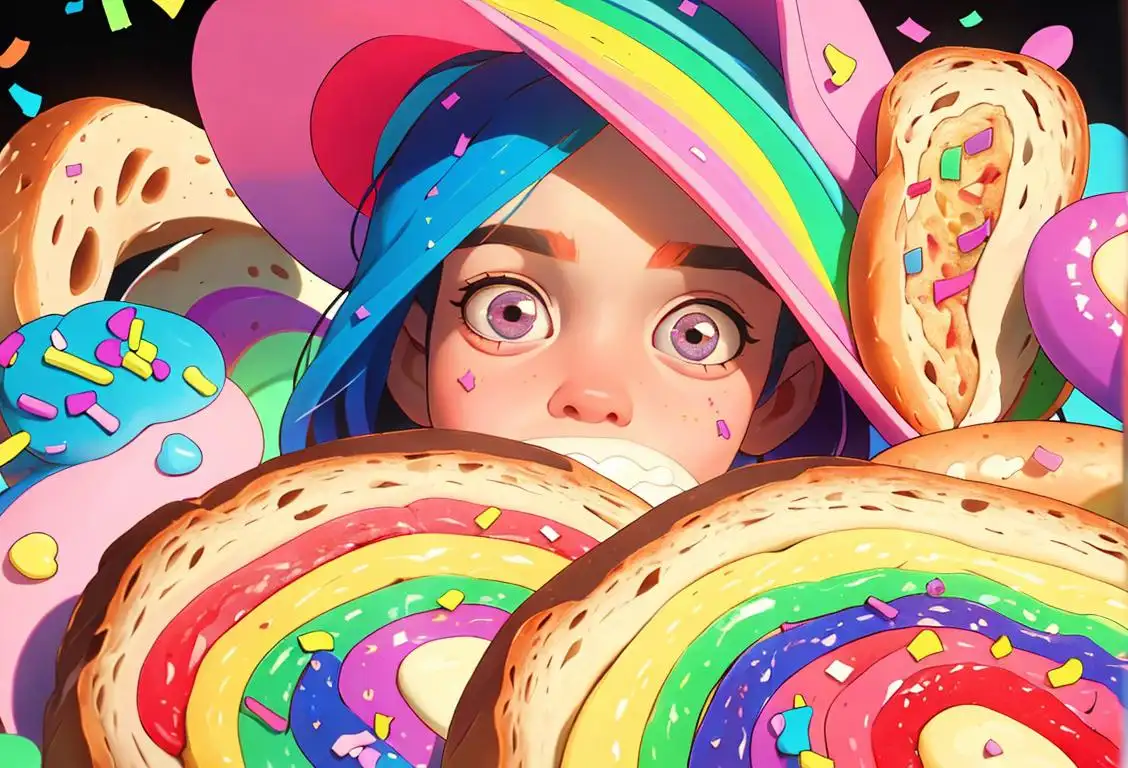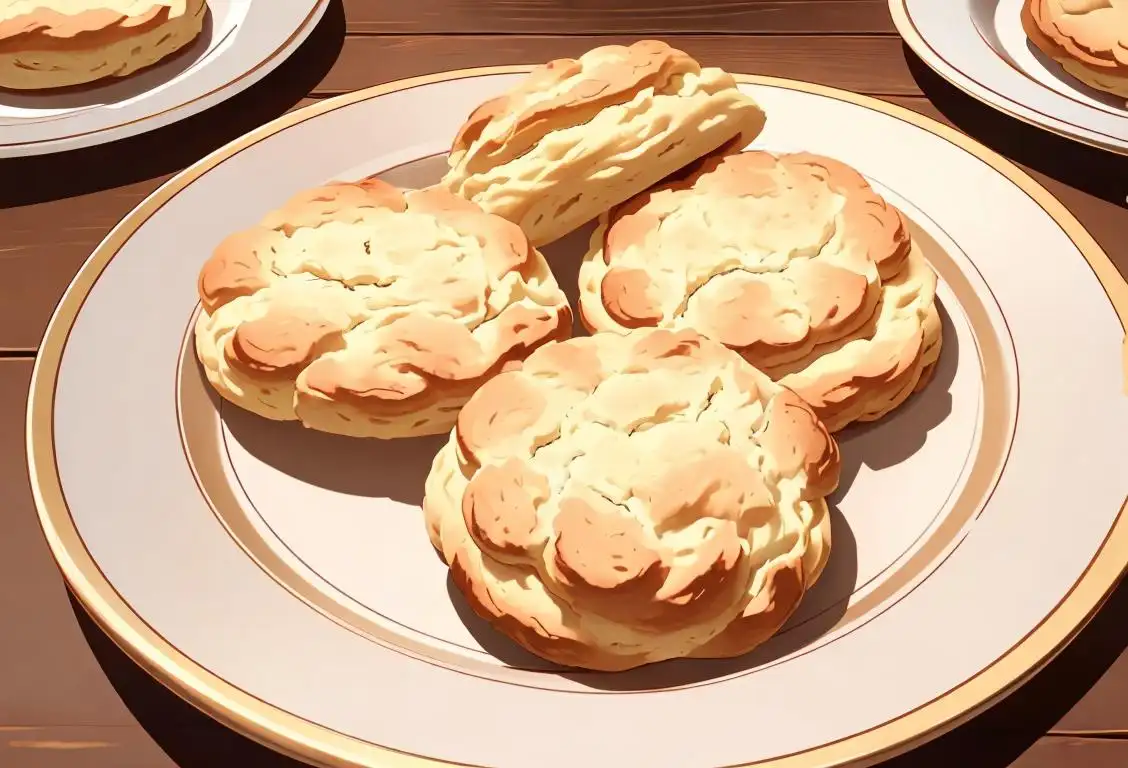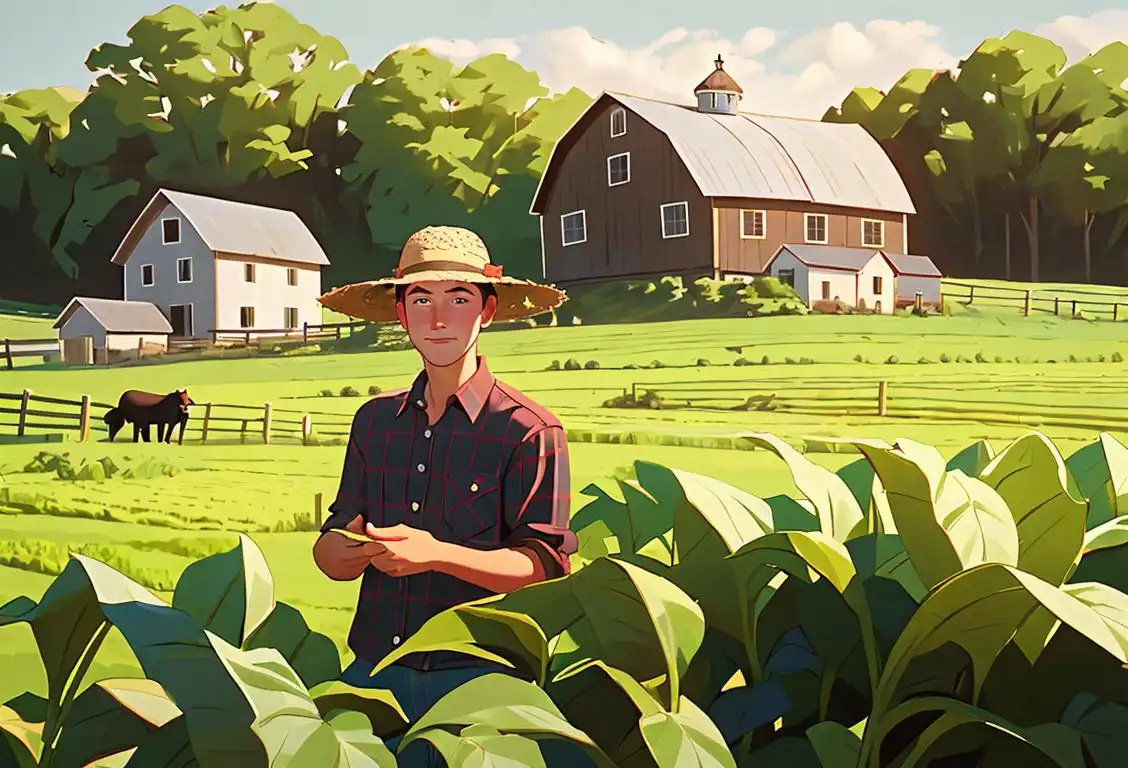National Fairy Bread Day

Welcome to the magical world of National Fairy Bread Day! Get ready to sprinkle some fun and sweetness into your life with this delightful celebration.
When is Fairy Bread Day?
It's national fairy bread day on the 24th November.
The Origins of Fairy Bread
Legend has it that Fairy Bread first made its appearance in the land down under, Australia. This whimsical treat has been gracing birthday parties and picnics for many generations, bringing joy to both children and adults alike.
What is Fairy Bread?
Now, you might be wondering, what exactly is Fairy Bread? Well, my friend, let me explain: it's a true masterpiece of culinary simplicity. Picture slices of fluffy white bread, spread generously with butter, and then adorned with a vibrant coating of hundreds and thousands, also known as sprinkles. The end result? A burst of color and sweetness that simply makes your taste buds dance with delight.
Fairy Bread is not just a treat; it's a symbol of pure childhood bliss. It takes you back to a time when life was simple, and the biggest worry was how many slices you could devour in one sitting.
Celebrating National Fairy Bread Day
On this special day, we invite you to embrace your inner child and indulge in the magic of Fairy Bread. Gather your loved ones, spread a little butter, and liberally sprinkle those hundreds and thousands. Whether you're hosting a party, planning a picnic, or simply craving some nostalgic comfort, Fairy Bread is the perfect way to celebrate. Remember, there's no age limit for a delicious trip down memory lane.
Fairy Bread Fun Fact
Did you know that Fairy Bread has its own dedicated song? Yes, that's right! In Australia, there's a popular children's song called 'Fairy Bread' that celebrates this iconic treat. It's catchy, it's fun, and it will make you crave Fairy Bread even more!
History behind the term 'Fairy Bread'
1929
Introduction of hundreds and thousands
In 1929, a popular confectionery product called 'hundreds and thousands' was introduced to the market. These tiny sugar-coated candies came in a variety of bright colors and were often used as cake decorations. They quickly became a favorite among children and were considered a fun and whimsical addition to baked goods.
1920
Origin of fairy bread
Fairy bread is believed to have originated in Australia in the 1920s. This iconic party food consists of slices of white bread spread with butter and generously topped with colorful sprinkles or hundreds and thousands. The combination of the soft bread, creamy butter, and crunchy sprinkles creates a simple yet delightful treat that has become a staple at children's birthday parties and gatherings.
1920
Introduction of sprinkles
In the early 1920s, sprinkles, also known as hundreds and thousands, were introduced. These tiny, colorful sugar candy decorations quickly became popular for adding a touch of whimsy and sweetness to various desserts.
1920
Introduction of white bread
In 1920, white bread became widely available in Australia. Previously, bread was typically made from whole wheat or rye flour, but the introduction of white bread brought a new level of softness and sweetness to the palate of Australians.
1920
Introduction of fairy bread
Fairy bread, a beloved Australian children's treat, made its first appearance in 1920. This colorful and whimsical treat consists of slices of buttered bread topped with hundreds and thousands, also known as sprinkles or nonpareils. The vibrant colors and sweet taste quickly captured the hearts of children and became a staple at birthday parties and school events.
1920
Origin of Fairy Bread
Fairy bread, a beloved Australian treat, originated in the 1920s. It is a simple yet delightful snack that consists of buttered bread sprinkled with hundreds and thousands, also known as rainbow sprinkles.
1929
The Invention of Fairy Bread
Fairy bread originated in Australia in 1929. It is a colorful and whimsical treat made by spreading butter or margarine onto a slice of white bread and then sprinkling it generously with hundreds and thousands, also known as sprinkles or nonpareils. The name 'fairy bread' is thought to have been inspired by the magical, ethereal look of the colorful toppings.
1920
The Birth of Fairy Bread
In the year 1920, the term 'fairy bread' came into existence, originating in Australia. It refers to a popular children's treat which consists of white bread spread with butter or margarine and sprinkled with colorful, hundreds-and-thousands (nonpareil sprinkles). Fairy bread is often served at children's parties and is loved for its bright and playful appearance.
1929
The birth of fairy bread
Fairy bread, a beloved Australian treat, was first mentioned in 1929. It is said to have originated at children's tea parties in the early 20th century. This delicacy immediately caught the attention of kids with its colorful and enchanting appearance.
1920
Introduction of Rainbow Bread
In the 1920s, a colorful and vibrant bread called Rainbow Bread was introduced in Australia. This bread had a unique appearance due to the use of various food colorings in the dough. The eye-catching colors made it an instant hit among children and sparked the idea of creating a fun and whimsical treat.
1929
Invention of hundreds-and-thousands
Hundreds-and-thousands was invented by an Australian company now known as McCormick Foods. These small, colorful sugar sprinkles became popular as a topping for desserts and baked goods.
1920
The Birth of Fairy Bread
Fairy bread, the iconic Australian children's treat, was first introduced in 1920. It is believed that an Australian company called Arnott's Biscuits developed the concept and named it fairy bread because it was so colorful and magical, just like fairies.
1936
Fairy bread recipe published
In 1936, a recipe for 'Fairy Bread' was published in the Australian Women's Weekly magazine. The recipe instructed readers to spread butter on slices of white bread and then sprinkle them with hundreds and thousands. This simple yet visually appealing treat was specifically aimed at children's parties and quickly gained popularity as a staple party food.
1920s - 1930s
Sprinkle sandwiches gain popularity
During the 1920s and 1930s, spreadable toppings like butter or margarine became increasingly popular for sandwiches. It was around this time that someone came up with the idea of using sprinkles as a fun topping for these spreads, creating what would later be known as fairy bread.
1930s
Growing popularity
During the 1930s, fairy bread gained popularity among Australian children and families. It was often served at special occasions such as picnics and school events. The bright and playful appearance of fairy bread made it particularly appealing to youngsters, and it quickly became synonymous with childhood celebrations.
The Influence of Children's Parties
The Influence of Children's Parties
In the following years, fairy bread became synonymous with children's birthday parties and other festive occasions in Australia. It became a staple at kids' parties, often served alongside other traditional party foods and sweets. The bright colors and simplicity of fairy bread made it a hit with children, who loved the combination of buttery bread and crunchy sprinkles.
1950s
Popularization at birthday parties
During the 1950s, fairy bread became a staple at children's birthday parties in Australia. The classic recipe consists of buttered white bread, sprinkled generously with hundreds and thousands, or rainbow-colored sugar sprinkles. The vibrant colors and sweet taste made it an instant hit among young partygoers.
1929
First mention of 'fairy sandwiches'
In 1929, the term 'fairy sandwiches' appeared in a cookbook called 'The Australian Woman's Mirror.' The recipe described a simple treat consisting of thinly sliced white bread, butter, and hundreds and thousands, which are small colorful sugar sprinkles.
1930
Popularity Amongst Children
By the 1930s, fairy bread had gained immense popularity among Australian children. It became a staple at children's parties and quickly became synonymous with joy and celebration.
Mid-20th Century
Rise in Popularity
During the mid-20th century, fairy bread gained immense popularity in Australia, especially at children's parties. It became a staple at birthday celebrations and other festive occasions.
1950
Fairy bread becomes popular at children's parties
Fairy bread gained widespread popularity in the 1950s as a must-have item at children's parties. The appeal of this simple yet delightful treat spread across Australia, and it became a staple on party tables. The joy of biting into a slice of buttered bread covered in colorful, crunchy sprinkles brought smiles to countless children's faces.
1930
Growing Popularity
During the 1930s, fairy bread gained significant popularity in Australia. The colorful and inexpensive treat quickly became a staple at birthday parties, picnics, and other children's gatherings. Fairy bread became a symbol of joy and celebration, delighting kids with its simple yet magical allure.
1929
First Mention of Fairy Bread
The term 'fairy bread' was first mentioned in a cookbook published in 1929 called 'Commonsense Cookery Book: Book 1' by the New South Wales Public School Cookery Teachers' Association. The book included a recipe for Fairy Bread, describing it as a children's party treat consisting of buttered bread sprinkled with hundreds and thousands (colorful sugar sprinkles).
1931
The birth of fairy bread
Fairy bread made its first appearance at a children's party in Australia. It was created as a simple and affordable treat for kids, consisting of buttered bread with hundreds-and-thousands sprinkled on top.
1950s
Renaming to 'fairy bread'
During the 1950s, 'fairy sandwiches' began to be referred to as 'fairy bread,' becoming the more widely used term. This delightful treat started to gain popularity at children's birthday parties and became an Australian classic.
1950s
Rising Popularity and Party Staple
During the 1950s, Fairy Bread gained significant popularity as a staple at children's birthday parties and other special occasions in Australia. Its simplicity and colorful appearance made it a favorite among kids, and it became synonymous with fun and festivities.
1970
Cultural impact of fairy bread
During the 1970s, fairy bread became an integral part of Australian childhood and culture. It symbolized the innocence and joy of childhood parties and celebrations. The iconic combination of bread, butter, and sprinkles not only satisfied cravings but also created cherished memories. The cultural impact of fairy bread extended beyond Australia, as it became known and enjoyed in other parts of the world.
1960s
Fairy bread in school lunches
Fairy bread gained popularity beyond birthday parties and started appearing in school lunchboxes during the 1960s. It became a lunchtime favorite due to its simplicity and the joy it brought to children's faces. Kids would eagerly unwrap their sandwiches to reveal the magical sprinkles on top.
1980
Cultural Icon
By the 1980s, fairy bread had firmly established itself as a cultural icon in Australia. The treat was beloved by generations of Australians, evoking feelings of nostalgia and happiness. It became ingrained in the nation's identity, embodying the carefree and lighthearted spirit of childhood.
1950
Sprinkles Take Over
In the 1950s, the traditional topping of fairy bread, which consisted of butter and hundreds and thousands (sprinkles), became the norm. Sprinkles added an extra element of color and fun to the already delightful treat.
1950s
Featured in recipe books
In the 1950s, fairy bread started appearing in Australian recipe books, solidifying its place in the culinary tradition of the country. The simplicity and affordability of the ingredients made it accessible to people from all walks of life, and it became a beloved treat that transcended social boundaries.
1940s
Rising popularity
Fairy bread gained popularity in Australia, becoming a staple at children's parties and school events. Its bright and colorful appearance made it a hit among kids, and it became a symbol of joy and celebration.
1940s
Fairy bread gains recognition in Australia
In the 1940s, fairy bread started gaining recognition in Australia as a popular treat for children's parties. The colorful and playful appearance of fairy bread made it a hit among kids, and it soon became a staple at birthday celebrations.
1950s
Fairy bread at Australian children's parties
Throughout the 1950s, Fairy Bread became a beloved fixture at Australian children's parties. It was often served alongside other classic treats like lamingtons and sausage rolls. The colorful and playful nature of Fairy Bread made it an instant hit with kids, who delighted in the combination of buttery bread and crunchy, sugary sprinkles.
1960s
Cultural Icon
In the 1960s, fairy bread solidified its position as a cultural icon in Australia. It symbolized the simple joys of childhood and the exuberance of carefree celebrations.
The Spread of Fairy Bread
The Spread of Fairy Bread
As time went on, fairy bread gained popularity outside of Australia, particularly in countries like New Zealand and the United Kingdom. This spread may be attributed to the growing popularity of Australian culture and the increased globalization of food trends. Fairy bread began appearing at children's parties and other celebrations in these countries, introducing new generations to this delightful treat.
Present Day
Fairy bread remains a beloved treat
Fairy bread continues to be a beloved treat in Australia and has gained some popularity in other parts of the world as well. It is commonly prepared by spreading butter or margarine on slices of white bread and then generously covering it with colorful sprinkles. The vibrant and nostalgic nature of fairy bread makes it a cherished part of many childhood memories and celebrations.
2000
Cultural Icon
Fairy bread has become a cultural icon in Australia, often associated with childhood nostalgia and happy memories. It is not only enjoyed by children but also by adults who indulge in the sweet, simple pleasure of this beloved treat.
21st Century
International Recognition
In the 21st century, fairy bread started to gain international recognition, thanks to its growing presence on social media platforms and the emphasis on unique cultural foods. People from around the world were captivated by the whimsical nature of fairy bread. It became a symbol of Australian culinary culture and a sweet reminder of childhood innocence.
1970s
Cultural icon
Fairy bread became deeply ingrained in Australian culture, representing nostalgia for childhood and a sense of national identity. It continued to be a beloved treat at birthday parties and special occasions.
1970s
Fairy bread as a nostalgic party staple
By the 1970s, fairy bread had firmly established itself as an iconic part of Australian culture and children's parties. The simple combination of bread, butter, and sprinkles continued to be loved by generations of Australians, evoking feelings of nostalgia and fond memories.
1980s
Cultural icon
By the 1980s, fairy bread had firmly established its status as a cultural icon in Australia. It became a must-have inclusion at children's birthday parties, where it would be served alongside other beloved treats like sausage rolls and party pies. The allure of fairy bread lies in its nostalgic and whimsical appeal, evoking fond memories of carefree childhoods and joyful celebrations.
Modern Era
Continued Tradition
Today, fairy bread continues to be a cherished part of Australian culture. It is not only enjoyed by children but also holds a nostalgic charm for adults, evoking memories of joyous moments from their own childhoods.
Present day
Continued popularity and cultural icon
Fairy Bread has remained a popular treat in Australia and has even gained a level of cultural significance. It is often referenced as a nostalgic symbol of childhood parties and is still served at birthday celebrations and other festive gatherings. Some Australian cafes and bakeries have even created gourmet versions of Fairy Bread, experimenting with different bread types and using high-quality sprinkles to elevate the simple treat.
1990s
Iconic status and cultural significance
By the 1990s, fairy bread had achieved an iconic status in Australia's culinary culture. It became synonymous with childhood nostalgia and was often associated with carefree days, parties, and innocence. Many adults recall fond memories of gathering around party tables and indulging in this delightful treat.
The Evolution of Fairy Bread
The Evolution of Fairy Bread
While the traditional recipe for fairy bread has remained largely unchanged over the years, modern variations have emerged. Some people have experimented with different types of bread, such as using fluffy brioche or crusty sourdough. Others have added additional spreads like Nutella or cream cheese before sprinkling on the hundreds and thousands. These creative variations have allowed fairy bread to continue evolving while still remaining a beloved party favorite.
1990
Fairy bread's resurgence
In the 1990s, a wave of nostalgia brought fairy bread back into the limelight. Adults who grew up enjoying this treat reintroduced it at parties, evoking fond memories from their childhood. Fairy bread began appearing at weddings, baby showers, and even adult gatherings, showing its versatility and enduring appeal. It transcended generational boundaries, reminding everyone of the happiness found in simple pleasures.
21st Century
Cultural Icon and Variations
Fairy Bread has evolved into a cultural icon in Australia, often associated with nostalgia and childhood memories. While the classic version remains popular, creative variations have emerged over the years. Some people add Nutella or other spreads, while others use themed sprinkles or even edible glitter. These variations have helped to keep Fairy Bread fresh and appealing to new generations.
21st century
Expansion of fairy bread's popularity
In the 21st century, fairy bread's popularity has expanded beyond Australia's borders and gained recognition in other countries. It has become a symbol of simplicity, joy, and childhood, cherished by many as a whimsical treat. Fairy bread is often featured at themed parties, picnics, and even weddings, showcasing its enduring appeal.
Present
Variations and Modern Adaptations
Today, fairy bread continues to be a popular snack at children's parties and other festive occasions in Australia. It has also inspired variations and modern adaptations, such as using different types of bread, adding Nutella or other spreads, or experimenting with unique sprinkles. Fairy bread has truly evolved while maintaining its status as a beloved Australian treat.
Present day
Fairy bread's continued popularity
Today, fairy bread remains a beloved treat in Australia and has gained recognition worldwide. It continues to be cherished by children and adults alike, with variations and creative adaptations often seen at events and social gatherings. The enduring popularity of fairy bread is a testament to its ability to evoke joyful memories and bring people together in celebration.
Present
International recognition
Fairy bread has gained international fame and recognition, often appearing in articles and discussions about Australian cuisine and unique food traditions. It has become a symbol of whimsy and childhood innocence worldwide.
Present day
Continued popularity and variations
Fairy bread remains a cherished part of Australian food traditions, with its popularity persisting into the present day. While the classic recipe remains unchanged, variations have emerged, including using different bread types, spreads, and even incorporating additional toppings. Despite the evolution, fairy bread continues to evoke feelings of joy and whimsy, making it a delightful treat for both children and adults alike.
Present day
Continued popularity
Fairy bread continues to be a popular treat in Australia to this day. It has even gained some international recognition and has been embraced in other countries as a fun and colorful party snack. Despite its simplicity, fairy bread holds a special place in the hearts of Australians, reminding them of the joy and innocence of youth.
Did you know?
Did you know that Fairy Bread has its own dedicated song in Australia?Tagged
food fun loved onesFirst identified
24th November 2015Most mentioned on
24th November 2016Total mentions
188Other days
Biscuit Day
Cheese Lovers Day
Cheese Pizza Day
Agriculture Day
Bacon Day
Medal Of Honor Day
Pumpkin Day
Foundation Day
Guac Day
Drink A Beer Day









